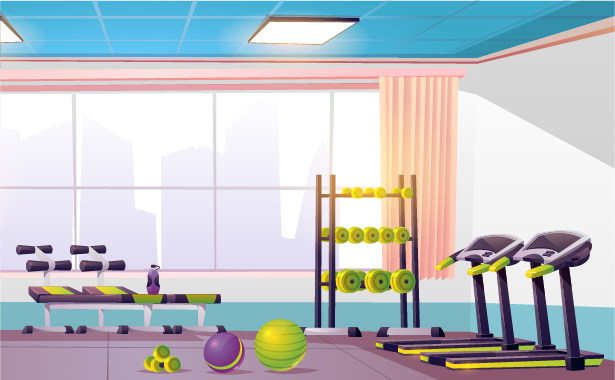Contents
What is a Boutique Fitness Studio?
Contrary to big-scale gyms, small-scale studios focus on a specific kind of exercise or a few in a similar setting. Because it is a strict emphasis on one particular fitness or exercise routine and fitness, instructors are likely to be more experienced than in a typical commercial gym. These studios often get the name of gyms which typically range from 800-3500 sq ft. Also, the boutique gym gives you a unique, meaningful experience because the space is usually very limited, and reservations are usually needed in advance. As opposed to gyms, these have cancellation or no-show costs.
If you have a passion for fitness and want to open your own boutique studio, this article is for you. We’ll walk through the steps of starting a successful boutique fitness studio, including analyzing the market, creating a business plan, choosing a location and venue, registering with government agencies and getting permits, hiring great instructors and trainers, designing an effective marketing plan that includes an online presence—plus more!
Are Boutique Fitness Studios Profitable?
Boutique fitness studios can be the perfect source of income if you have a passion for the job and if you take the necessary steps with the necessary tools.
Let’s take a look at the 9 most crucial steps that will show you just how to start a Boutique fitness studio and get the ROI you want.
1. Create your business plan
Step 1: Create a business plan.
Without a business plan, you will have trouble getting financing and meeting with investors. You’ll also be at a disadvantage when it comes to hiring employees or finding partners for your studio. A good business plan means that you have a clear idea of what you want from your fitness studio as well as an understanding of the market in which you will be operating. In short, it’s like having a GPS for your fitness journey!
To create an effective business plan, follow these four steps:
- Identify your goals and objectives – What do you hope to achieve with this business? Why would someone pay for classes at your studio instead of another one nearby? Do people even need a new boutique fitness studio in their neighbourhood? How can they benefit from it? These are all questions that should be answered before moving forward with opening any kind of business—and they’re especially important when starting out on your own rather than joining an existing franchise operation or organization (like Planet Fitness).
* Create an outline – This is where you figure out how many pages should be included in your plan, what information goes on each page, and other details about the layout. For example, if you’re planning to open a yoga studio then maybe there’s one chapter devoted specifically to that topic. Or perhaps you’ll want two chapters: one discussing different types of yoga practices and another detailing how they can benefit people with certain illnesses or physical ailments.
Include financial projections – How much money do you think it will take to open the doors on Day One? Do some research and estimate how much revenue you’ll make from your first month of business.
2. Analyze the market for boutique fitness studios in your area
When you’re starting a boutique fitness studio, it’s important to understand the market and what your customers want.
Your target audience is essential because they are the ones that will be paying for your services. If you don’t have a clear picture of who they are and what they want, then it’ll be hard to figure out how best to serve them.
Do some research on other boutique fitness studios in your area. Are they more specialized than you? Do they offer classes with names like “The Booty Workout” or “Booty Camp”? How many followers do their Instagram accounts have? Are people posting pictures at their studios on social media? What type of people do these posts seem to attract?
If there are already many similar studios in your area, consider whether another one would be successful there. You may need to look at other communities or neighbourhoods where no one else is offering this kind of service yet–or perhaps even rebrand yourself as something new (like an “urban yoga studio”).
3. Choose a business structure for your boutique fitness studio
Before you can open your boutique fitness studio, there are a few things to consider. What kind of business structure will work best for your needs?
To be honest, it depends on how many partners or employees you have.
- Sole proprietorship: This is the easiest and least expensive structure because you don’t have to file any special paperwork; however, it has some drawbacks if you have partners or employees. As the sole owner of a sole proprietorship, all of your personal assets could be at risk if something goes wrong with the business (like defaulting on a loan). Also, there is no separation between personal and professional finances—everything is merged into one pot. So if a customer sues or files an insurance claim against your studio for injuries sustained during their session with one of your trainers, they could go after all of your assets as well!
- LLC (limited liability company): This option is popular among small businesses because it provides limited liability protection while also allowing some tax benefits similar to those available under an S-corporation without having to jump through additional hoops like filing corporate taxes separately from personal ones annually throughout each year that goes by since incorporation took place back in 2022 when this guide was first put together before being updated now in 2023 right now here today at noon pst tomorrow morning est tonight pacific timezone tomorrow night 9 pm eastern time 12 am central midnight mountain 3 am central 4 am eastern 5 am eastern 6 am eastern 7 am central 8 am east
But before we get into the specifics of what to look for, let’s talk about why you should consider a boutique fitness studio in the first place. Boutique studios have been around since 2006 and have since become incredibly popular among athletes, celebrities and businessmen alike. In fact, the popularity of these types of gyms is so great that they’re now opening up all over America.
4. Pick the right location and venue
- Location, location, location.
- It’s critical to choose the right location for your boutique fitness studio in order to attract the right clientele and make a profit. First, consider your target market and where those people live. Then think about whether or not you will have parking available and if there are other businesses nearby that cater to your target market. For example, if you are targeting moms with young children, then it may not be a good idea to open up shop in an area where there is no school nearby or no playgrounds within walking distance of your studio because those moms might not want to leave their kids at home with the babysitter while they work out at the gym (not saying this is true of all mothers).
5. Register your boutique fitness studio and get permits
Once you’ve figured out how big your boutique fitness studio will be, it’s time to register it and get permits. The local authorities will want to know who owns the business, how many employees will be working there, where the equipment is going to come from (if you don’t have any of your own), and what kind of food or refreshments you’re planning on serving at your boutique fitness studio. The federal government will want to know all sorts of information about your company: who owns it; where precisely is your physical location; whether any other people are working with you on this project; and what kind of financial status yours has been lately. If they ask whether anything like this has been done before in a similar location, tell them no!
The state government also wants information about who owns the business and where exactly in America it’s located—but if they ask about anything else related to financial status or previous experience with similar projects, tell them yes! That way, you can get more money out of them later when taxes are due!
Finally—and most importantly—the local government wants detailed plans for every aspect of operating this new venture: costs involved with purchasing necessary supplies; projected profits based on sales projections obtained through market research conducted by an outside firm hired by yourself (as opposed to one hired internally); expected impact upon surrounding businesses/properties due simply from having an establishment nearby offering lower prices than competitors nearby but higher quality service than competitors nearby.”
6. Make sure you have the right equipment
The final step in your equipment selection is making sure you have the right stuff. You’ll want to make sure that all of your equipment is safe and durable, well-maintained, easy to use, affordable, aesthetically pleasing, and functional.
There’s no reason why you can’t set up a gym that looks great without breaking the bank. The key is finding quality products at reasonable prices. We’ve created a model program to help guide your search through some of the best options available on Amazon today:
* The Paramount Fitness Network offers a complete line of gym equipment for home and commercial use. With over two hundred pieces to choose from, there are many options that will fit your needs and budget. Their products range from simple dumbbells and barbells to treadmills with high-tech features like touchscreens or digital consoles.
7. Get the right boutique fitness studio software and systems in place
You can’t be in two places at once and need to manage your boutique fitness studio as efficiently as possible. The right software will help you provide a better customer experience, improve your business intelligence, and generally save time and money.
You may already have some of these solutions in place if you have been working for many years or have had previous experience running a different type of business. However, if you are starting from scratch, it is vital that you get a studio management software from the very beginning. That way, your whole workflow will be optimized from the ground up, making everything simpler and more efficient.
There are a lot of different studio management apps around, and if you take a look at some of the listings, you’ll notice that each focuses on some specific features and lacks most of the others. Dealing with this has been why we created RunSensible to be the comprehensive, all-in-one studio management solution. With literally everything you need to start and grow your boutique gym, our platform will considerably increase your chances of success. From lead generation and email marketing to scheduling and time-tracking onto invoicing and payment, RunSensible will simplify your business. You can also use it to get a dedicated business phone or set up your website for content marketing to bring in more new leads. Since everything will take much less time now, you can do a lot more than you would without RunSensible.
8. Hire and manage great instructors, trainers, or coaches
The importance of hiring the right people can’t be overstated. The staff is your first impression on clients, and if you’re not careful, it can make or break your studio.
How do you find them? You might be tempted to just hire anyone who’s willing to work for less than $10 an hour. Don’t do that! The best way to get great instructors is by word-of-mouth; once someone hears that an instructor at your studio is good (or bad), they’ll tell others about it. If you have a stellar reputation in town, then it’s easy enough to attract new talent; if not, well…good luck!
After finding these wonderful people with great attitudes and aptitudes for working with groups of diverse fitness levels and abilities—not as easy as one would think—you must manage them effectively while also training them properly, so they deliver exceptional results in their classes each day. This includes providing adequate equipment (don’t skimp here) and offering ongoing coaching opportunities so that everyone stays motivated throughout their careers at your organization.”
9. Design a marketing plan, create a website and start selling classes online
Your next step will be to design a marketing plan, create a website and start selling classes online.
You’ll need to make sure that you have the right equipment and software, but it is absolutely crucial that you have an online presence in 2022. If people don’t know what your studio is or how to find it, they won’t come. You can still have success without having an online presence in 2022, but we recommend investing in this early on because as more people get used to buying things online (and more businesses go out of their way to make it easy for their customers), it will become increasingly difficult for studios that don’t take advantage of these new technologies.
10. Learn to train
For all the staff within the boutique studio, it is important to ensure that everyone is educated, which includes you. Ideally, you are sure that all employees are trained to the same standard and have experience in different tasks and interactions.
For instance, you’ll need to ensure that everyone is properly trained on promotion, handling issues, basic administration, and much more. This kind of training can allow employees to take over and perform multiple tasks if they become sick or sick.
11. Permits to gain and insurance
Before you can operate your fitness studio, obtaining the necessary permits and insurance that will protect your business from being fined or sued. The kinds of permits that you ought to be thinking about getting are:
State and Local Business
The local and state governments may require specific permits for operating your own fitness studio. So, based on the area you’re located in consult with local councils to learn more about what’s required.
Liability Waiver
If you are a fitness professional, The last thing you wish to do is to be legally liable for your clients. So, you should have a liability waiver your must clients sign to restrict the legal liability. The agreements will protect you from the possibility of injuries to clients from hazardous equipment as well as physical exercise.
Certificate of occupancy
Brick and mortar companies nowadays are often required to prove they’ve got an official certificate of occupancy. This is a certification issued by a third-party that proves you’ve complied with all building codes, local laws and federal regulations.
Last Steps: Get Started Already!
Taking that first step that sets everything in motion can be more than a little challenging. I know people who never started the business they wanted just because they could not go ahead with it in the end. At this stage, you shouldn’t try to backtrack and re-check everything — instead of going full OCD, try to forge ahead and take the first step. As easy as that. Taking the next step will be a lot easier.
How to Start a Boutique Fitness Studio: Challenging but Doable
You may be thinking, “Opening a boutique fitness studio is probably the hardest thing I could ever do.” And you’d be right. It takes lots of time, money, and energy to get off the ground. But if you follow a winning formula for success, it becomes much more manageable—and possible.
For example: You have an idea for a new business that seems like it will work based on what other businesses in your industry are doing right now. You go ahead and start building out your plan (business model) with all of its components (services/products offered), but then discover that most of these services are already offered elsewhere—so why would anyone want yours?
Don’t worry! That’s where we come in! We’ll help guide you through each step so that when it comes down to opening day at your new gym or studio location, everyone is excited about what they’re hearing from our speakers at conferences like Fitness Business Summit NY City 2020 as well as backed by data collected through surveys taken online by users who sign up via email or SMS text message alert service that RunSensible will provide as part of its communications features!
The Advantages of a Boutique Gym
There are many advantages for you as the owner of the gym and your members of the gym if you’re thinking of opening a fitness studio that is boutique which includes:
Creates an entire community
As we said earlier Boutique fitness is a type of fitness that tends to focus on one kind of fitness or two. In contrast to general gyms, this particular concept usually attracts people who are looking for exercise only, or who want to concentrate on it only.
Contrary to gyms that are commercial which have a lot of members who hop from class to class the members of these gyms are motivated to work hard and improve at the specific exercise. Because of this, many members have the opportunity to be social and get to know each other because of their shared interests and objectives.
Add a highly skilled and qualified instructor and you’ve got yourself an entire group of committed individuals who will show up every time.
Profitable
If you’re well-organized with your finances, marketing and an extensive understanding of business, starting and running a boutique business can be extremely lucrative. Since numerous boutique studios that are successful quickly make money within 6-18 months of launching.
In addition to charging for classes in addition to the cost of classes, you can charge students for cancellations last minute as well as locker fee. However, before jumping into running your business you must consider what you can expect from your service and location, messaging costs, and advertising.
Members get individual attention
In comparison to commercial gyms, boutique studios are a lot more intimate. Small classes held in boutique studios allow instructors ample time to walk around and begin reviewing the forms of students, encouraging the students with encouraging words of encouragement to not abandon the effort. In addition, because of the greater attention given to students, it is likely that they will be able to see improvements faster than those in the fitness center.
Costlier to put up than an exercise facility
Since boutique studios are a much smaller size than commercial gyms and will cost less to build and rent depending on the site. Furthermore, it is easier to install the equipment and you don’t have to employ more employees to maintain the facility.
Hygienic
Comparatively to the local gyms Boutique fitness studios tend to be much more clean. It’s because there’s less equipment to be cleaned regularly as well as fewer visitors entering and out.
Additionally, since it’s a smaller area dirt may show up much more readily and it’s much more motivating to keep it tidy. In addition, because of the pandemic, it will aid your staff members to feel more secure knowing that your area is clean and in a position to use the proper social distancing.
More accountability
Since boutique fitness facilities have a more personal touch they are less likely that clients will fall through the gaps. By this, we mean that there are many reasons that make them accountable to continue showing up and making the time count.
In the first place, there is a fee for late arrivals or for cancellations with the smallest notice. In addition, in the majority of boutiques, instructors tend to get to know their customers more intimately, which allows them to locate them and track for them on social media when they’re absent. This is why accountability can aid in keeping members.
A positive and ego-free atmosphere
Some of the more experienced members may assist in gyms, however, they can appear intimidating to new clients. People may also be anxious in a gym, and therefore avoid working out in a proper manner.
For Your Fitness
Business
However, most exercise with an interest that is shared and similar goals, resulting in a familiar feeling of purpose in the help of a boutique gym. The group’s motivation helps build one another up, and help the fitness goals rather than making them feel like they’re failing.
Efficiency
Members do not have to spend lots of time weighing equipment or altering their exercise routine until the equipment is available. With boutique fitness centers, clients can be aware of the duration of a workout or the time they spend using the equipment because they’ll need to reserve in advance using the app or on the website. This alone improves efficiency, organization, and the satisfaction of clients.
How to Start a Boutique Fitness Studio the Easy Way
If you follow the steps outlined above, then your boutique fitness studio should be up and running in no time. Remember that this is a long-term investment, so don’t expect overnight success. However, if you learn how to open a boutique fitness studio and stay focused on what matters most—your customers and their needs—then it won’t take long at all before they are calling themselves regulars!
In general, boutique fitness centers are more popular than ever before — whether that’s a gen-z thing or if everyone is looking for an alte
rnative to the bland and generic big gym experience, boutique gyms are here to stay. Perhaps a large part of their success is also due to the fact that studios are packed with positive energy for gym newbies and those who are nervous about visiting fitness centers. The welcoming atmosphere and the results-driven sessions that boutique fitness centers offer on their own can create an attractive option for fitness entrepreneurs of all kinds. Now is the time to turn your passion for fitness into a business and start by opening your own boutique fitness studio.
We have gone over the basic steps and know how to start a boutique fitness studio in theory. Remember, however, that the actual experience of starting your boutique gym will be a whole different story. But as long as you know the steps you need to take and have the right tools at your disposal, there is no reason to call things off. RunSensible is a comprehensive studio management software that’s trying to simplify the process of starting and growing a boutique fitness studio by bringing all the tools you’ll need into a single place — literally, all the tools you will need as a studio owner and fitness entrepreneur. Give RunSensible a try right now and see for yourself how much easier it will be to open a boutique fitness studio with our studio management software.
Disclaimer: The content provided on this blog is for informational purposes only and does not constitute legal, financial, or professional advice.






